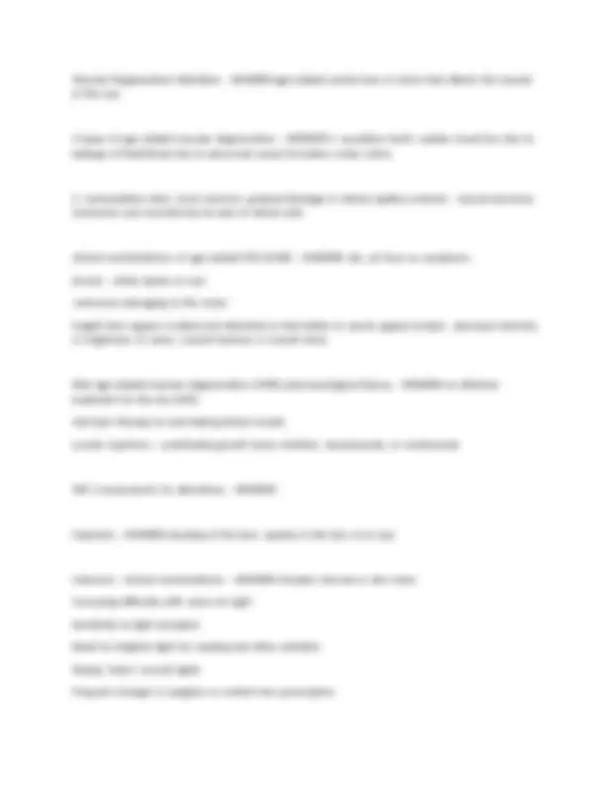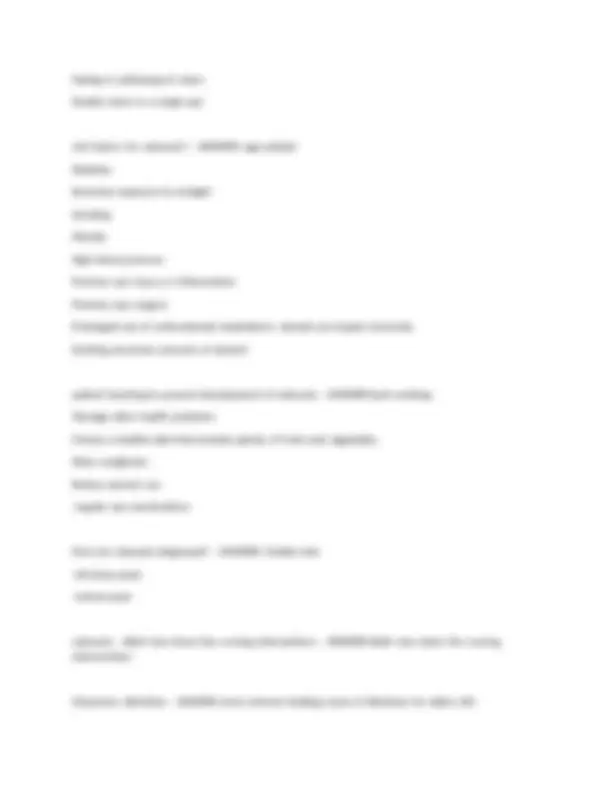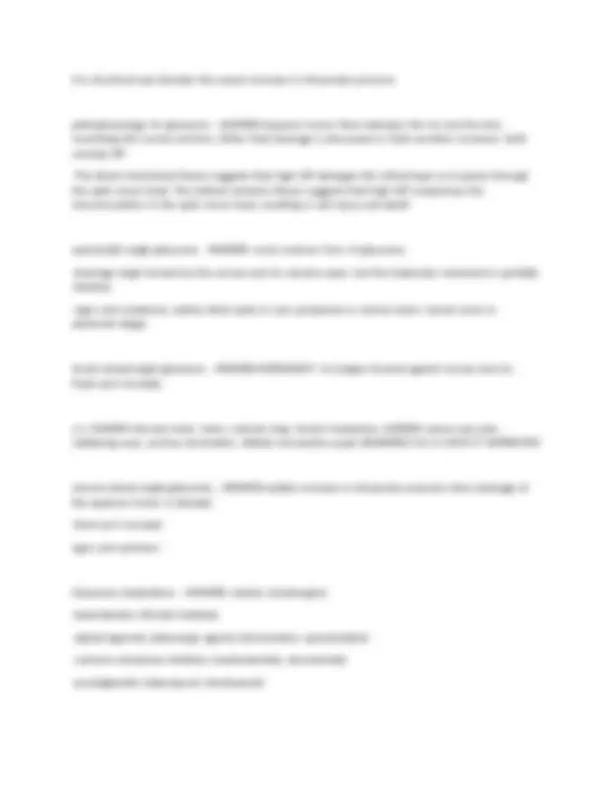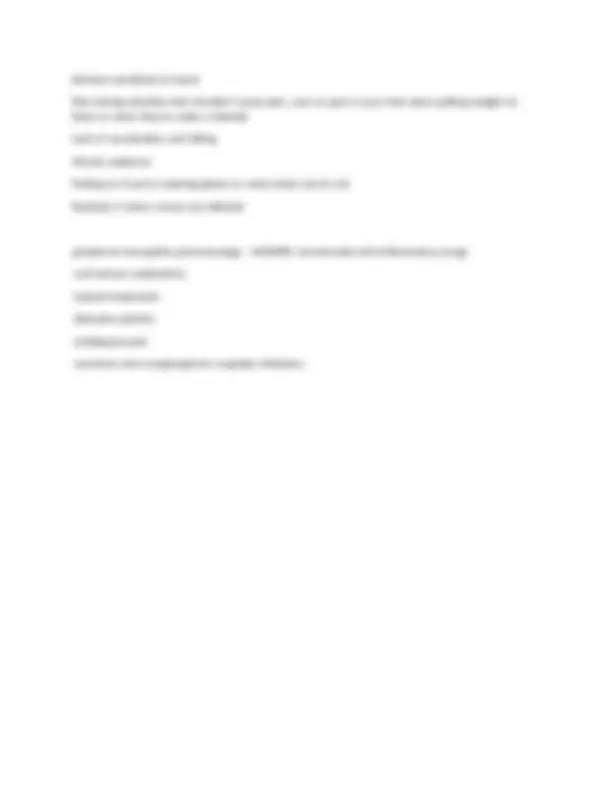






Study with the several resources on Docsity

Earn points by helping other students or get them with a premium plan


Prepare for your exams
Study with the several resources on Docsity

Earn points to download
Earn points by helping other students or get them with a premium plan
Community
Ask the community for help and clear up your study doubts
Discover the best universities in your country according to Docsity users
Free resources
Download our free guides on studying techniques, anxiety management strategies, and thesis advice from Docsity tutors
RNSG 1430 exam 2 functional ability and sensory perception exam with verified answers.
Typology: Exams
1 / 8

This page cannot be seen from the preview
Don't miss anything!





Sensory |Perception |(S/P) |- |ANSWER-reactions |to |external |stimuli |which |can |be |visual, |auditory, | olfactory, |tactile |and |gustatory. Sensory |Perception |- |attribute |- |ANSWER-capacity |to |perform |actual/required |activities S/P |antedecents |- |ANSWER-- |developmental |milestones
-nutrition -safety factors |affecting |S/P |- |ANSWER--developmental |considerations -culture -personality |and |lifestyle medication What |are |the | 2 |primary |components |of |sensory |perception? |- |ANSWER-Sensation |and |perception |or | reception |and |perception. (S/P) |where |does |the |interpretation |of |sensory |experience |occur? |- |ANSWER-cranial |nerves |- |reticular | activating |system |(RAS) |- |hypothalamus |to |medulla |= |arousal. (S/P) |safety |considerations |for |pts |with |sensory |perception |deficits? |- |ANSWER--assess |how |the | patient |is |coping |then |develop |a |care |plan |- |are |they |able |to |compensate |for |the |deficit? | -Illness |and |hospitalization |may |threaten |a |patient's |usual |adaptive |patterns |and |require |new |self-care |abilities. |Patients |with |evolving |deficits |will |require |assistance |with |coping |and |learning |to | compensate |skillfully. (S/P) |describe |health |promotion |teaching |to |minimize |risk |of |S/P |deficits. |- |ANSWER- 3 |examples |of |alterations |of |S/P |- |ANSWER--sensory |deficit: |change |in |reception/perception -sensory |deprivation: |reduced |sensory |input |(Int/ext) |(due |to |illness, |trauma, |or |isolation) -sensory |overload: |excessive |sustained, |and |unmanageable |multisensory |stimulation eye |injuries/conditions |that |are |emergent |and |can |lead |to |vision |loss: |- |ANSWER--corneal |abrasion -penetrating/perforating |trauma -retina |detachment: |caused |by |aging |or |eye |injury |(star |fish |image |comparison)
Fading |or |yellowing |of |colors Double |vision |in |a |single |eye risk |factors |for |cataracts? |- |ANSWER--age-related Diabetes Excessive |exposure |to |sunlight Smoking Obesity High |blood |pressure Previous |eye |injury |or |inflammation Previous |eye |surgery Prolonged |use |of |corticosteroid |medications: |steroid |use |impairs |immunity Drinking |excessive |amounts |of |alcohol patient |teaching |to |prevent |development |of |cateracts |- |ANSWER-Quit |smoking. Manage |other |health |problems. Choose |a |healthy |diet |that |includes |plenty |of |fruits |and |vegetables. Wear |sunglasses. Reduce |alcohol |use -regular |eye |examinations How |are |cataracts |diagnosed? |- |ANSWER--Snellen |test -slit |lamp |exam -retinal |exam cataracts |- |didnt |wire |down |the |nursing |interventions |- |ANSWER-didnt |wire |down |the |nursing | interventions Glaucoma: |definition |- |ANSWER-most |common |leading |cause |of |blindness |for |elders |60+. |
it |is |structural |eye |disorder |tha |causes |increase |in |intraocular |pressure pathophysiology |for |glaucoma |- |ANSWER-Aqueous |humor |flows |between |the |iris |and |the |lens, | nourishing |the |cornea |and |lens. |Either |fluid |drainage |is |decreased |or |fluid |secretion |increases- |both | causing |IOP. -The |direct |mechanical |theory |suggests |that |high |IOP |damages |the |retinal |layer |as |it |passes |through | the |optic |nerve |head. |The |indirect |ischemic |theory |suggests |that |high |IOP |compresses |the | microcirculation |in |the |optic |nerve |head, |resulting |in |cell |injury |and |death. open(wide) |angle |glaucoma |- |ANSWER--most |common |form |of |glaucoma. -drainage |angle |formed |by |the |cornea |and |iris |remains |open, |but |the |trabecular |meshwork |is |partially |blocked. -signs |and |symptoms: |patchy |blind |spots |in |your |peripheral |or |central |vision, |tunnel |vision |in | advanced |stages Acute |closed-angle |glaucoma |- |ANSWER-EMERGENCY: |iris |bulges |forward |against |cornea |and |iris. | Fluid |can't |circulate. s/s: |SUDDEN |blurred |vision, |halos, |colored |rings, |Severe |headaches, |SUDDEN |severe |eye |pain, | reddening |eyes, |profuse |lacrimation, |dilated |nonreactive |pupil, |BLINDNESS |IN |2-5 |DAYS |IF |UNTREATED narrow |(close) |angle |glaucoma |- |ANSWER-sudden |increase |in |intraocular |pressure |when |drainage |of | the |aqueous |humor |is |blocked. -fluid |can't |circulate signs |and |symtoms: Glaucoma |medications |- |ANSWER--miotics |(cholinergics) -beta-blockers |(timolol |meleate) -alpha2-agonists |(adrenergic |agents) |(brimonidine, |apraclonidine) -carbonic |anhydrase |inhibitors |(acetazolamide, |dorzolamide) -prostaglandins |(latanoprost, |bimatoprost)
hearing |loss |risk |factors |for |adults |- |ANSWER-advancing |age |and |ototoxic |medications |(NSAID's, | diuretics, |monobactams) Conductive |hearing |loss |treatment |- |ANSWER-Treat |underlying |condition Treatment |- |amplification |using |a |hearing |aid. Steroids, |Antibiotics |for |Rx. |Of |Otitis |Media peripheral |neuropathy |- |ANSWER-disorder |of |the |peripheral |nerves |that |carry |information |to |and | from |the |brain |and |spinal |cord Peripheral |neuropathy |risk |factors: |(all |that |apply) |- |ANSWER-Autoimmune |diseases. Diabetes. Infections.. Inherited |disorders |- |Charcot-Marie-Tooth |disease Tumors. |Growths, |cancerous |(malignant) |and |noncancerous |(benign Bone |marrow |disorders. Other |diseases |such |as |kidney |, |liver |, |connective |tissue |disorders |and |an |underactive |thyroid | (hypothyroidism). Alcoholism. Exposure |to |poisons. Medications Trauma |or |pressure |on |the |nerve. |Vitamin |deficiencies Peripheral |neuropathy |safety |considerations: |- |ANSWER-Conditions |that |result |when |nerves |that |carry |messages |to |and |from |the |brain |and |spinal |cord |are |damaged |or |diseased Causes |weakness, |numbness |and |pain, |usually |in |your |hands |and |feet. |It |can |also |affect |other |areas | of |your |body. Gradual |onset |of |numbness, |prickling |or |tingling |in |your |feet |or |hands, |which |can |spread |upward |into |your |legs |and |arms Sharp, |jabbing, |throbbing |or |burning |pain
Extreme |sensitivity |to |touch Pain |during |activities |that |shouldn't |cause |pain, |such |as |pain |in |your |feet |when |putting |weight |on | them |or |when |they're |under |a |blanket Lack |of |coordination |and |falling Muscle |weakness Feeling |as |if |you're |wearing |gloves |or |socks |when |you're |not Paralysis |if |motor |nerves |are |affected peripheral |neuropathy |pharmacology |- |ANSWER--nonsteroidal |anti-inflammatory |drugs -anti-seizure |medications -topical |treatments -lidocaine |patches -antidepressants -serotonin |and |norepinephrine |reuptake |inhibators